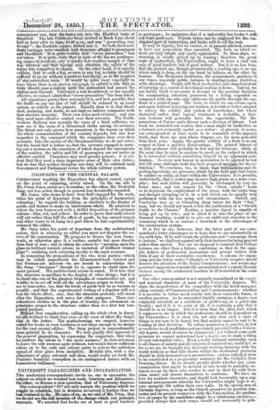COLOURING OF THE CRYSTAL 'ALICE:
CliNTROVERSY touching the Exposition has almost ceased, except on the point of colouring„ newly raised, On the one side le Mr. Owen Jones, noted as a decorates; on the other, Mr.- Frederick Sang, not less noted, though in general less favourably. regarded.
Mr. Jones, who seems.to have been half' engaged for the work, takes his point of departure from. the principles of harmonious colouring ; he regards the building, as, ancillary ten the dieplay of goods, and desires tut make an harmonious- whole, He proposes to colour the iron framework with a skilful disposition of the primary coleurs—blue,- red, and yellow: In-order to prove that such colours will aid rather than kill the effect of goods, he has caused carpets and other wares to be hung inn part where he had experimentally coloured the edifice.
Mr. Sang, takes his point of departure from the architectural' axiom, that in adorning an edifice you mast; not-disguise the na- ture. or the construction. -Tel proposes to bronze the. iron flume- work„ or otherwise give it a surface metal/ie. but more durable than that of iron ; and to obtain his colour by .‘ painting upon the glass in brilliant varnish colour, in imitation of brilliant stained glass" : confining such colouring mostly to the main avenues. In comparing the propositions of the twa rival parties—which may be called respectively the Illuminated-book interest and the German-art interests—we are bound to acknowledge that Mr. Sang, " foreigner " though he is, appears to stand upon the surer ground; His architectural axiom is sound. It is true that the structure is ancillary to the display of. other things ; but it is initself also, one of the greatest triumphs of coustructive art, and worthy to be set off with all the advantages proper to itself. We are to remember too, that thelinds of geode-will be as various as possibl, and that the experimental testing of a fraction will not test the whole effect; also, that the structure probably will stand- after the Exposition, and serve for other purposes. These con, siderations incline us to the plan of treating the adornment on principles proper to the. structure rather than to a first but tem-
Pc*7 purpose. •
Beilsond that coneiileration, calling up the whole view in fancy, we are inclined to think that even on the score of effect Mr. Sang's idea is the better. The particolouringi we suspect, however suited for books or even boudoirs, is not large enough in its design for; the vast crystal edifice. The Sang project is unquestionably- more palatial in its character. We only qualify this approval of the-genera/ proposition, by expressing- the cenjecture, that when. he confines the colour to " the main avenues' " he does, not mean to leave the side avenues quite without, but would.throw sufficient colour on to the ends and salient parts to relieve the unbroken spread of clear glass from insipidity. Metellie ribs, with a due admixture of glass coloured andelear, would really set forth Itr. Paxton's beautiful conception ineite undisguised nature with- an harmonious brilliancy.


























 Previous page
Previous page